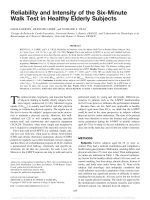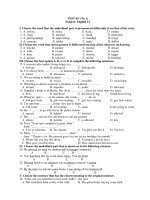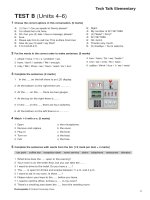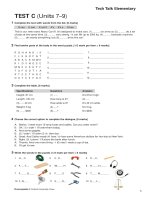100 test quiz of multimedia subject
Bạn đang xem bản rút gọn của tài liệu. Xem và tải ngay bản đầy đủ của tài liệu tại đây (63.87 KB, 22 trang )
100 test quiz of multimedia
1.JPEG encoder
input
1
2
3
4
5
output
3 + Adaptive quatization
5 + VLC
2 + DCT
4 + Zigzag scaning
1 + Partitions image
2. what is JPEG-DCT
a.Transforms a image from the spatial domain to frequency domain
*b.Transforms a signal or image from the spatial domain to frequency
domain
c. Transforms a slice from the spatial domain to frequency domain
3. VCD uses coding
a. MPEG-2
b. *MPEG-1
c. MPEG-4
d. MPEG-7
4.Smallest fundamental unit of MPEG video data structure
a. Bit
b. Block
c. Marcoblock
d. *Pixel
5.Characterization of DCT coefficient matrix
a. *Small in upper left large in upper right
b. Small in upper right large in below right
c. Radom
6.what does the slice header carry
a. Synchronization information
b. *Address information
c. Dimension information
7.I picture is
a. *Macroblock code without prediction
b. Macroblock code with forward and backward prediction
c. Macroblock code with forward prediction
8.Typical length of GOP
a. 25
b. *15
c. 16
d. 24
9.The head of GOP
a. P picture
b. B picture
c. *I picture
10.Quantity bit of sequence header in MPEG data structure
a. *32
b. 16
c. 8
d. 64
11. What is the type of data in pes
a. video and audio
b. video
c. audio
d. *single ES add packet header
12.What is the final transport packet of MPEG filled
a. not change
b. *stuffing with 0xFF bytes
c. stuffing with 0x00 bytes
d. radom bytes
13.What dose 8 bits of the PES header do
a. quantity information
b. *identifying the source of the payload
c. synchronization information
14.What dose MPEG use to replace signal RGB
a . *Y Cb Cr
b. Y Cg Cr
c. Y Cg Cb
d. Cr Cg Cb
15.What is the most commonly video format used in MPEG-2
a. 4:4:4
b. 4:2:2
c. *4:2:0
d. 4:4:2
16.What dose prediction do
a. increase speed
b. detect error
c. eliminate time delay
d. *encode and decode picture
17.Why is picture anchored before decoding
a. decrease error and repair error
b. *the encode transmit picture in order differ from source picture
c. for prediction to decode
18.How is MPEG scaning
a. Zig zag scaning
b. Alternate scaning
c. *Both
19.The packet header MPEG data transport have
a. *13
b. 8
c. 9
d. 16
20.What is the remaining space in the final transport packet payload MPEG
filled
a. *fill with stuffing bytes =0xFF
b. fill with stuffing bytes =0x00
c. fill with stuffing bytes =radom
d. not fill
21.The length of MPEG data transport packet is
a. fixed-side 128 byte
b. variable length
c. *fixed-side 188 byte
22. 8 bits packet header of MPEG transport packet
a. address receiver
b. synchronization and stamp
c. *specifying length of the adaptive filed
23. The data of MPEG-2 transport stream is
a. video stream
b. audio stream
c. *any type of data
d. text
24. Process demultiplexing
1
2
3
4
1+ finding the PAT by select packets with PID=0x0000
3+ reading the PIDs for the elements of a desire program from its PMTs
2+reading PIDs for the PMTs
4+detecting packets with the desire PIDs end routing them to decode
25.What dose PID do
a. discriminate address
b. *discrimination stream of video audio or other program element
26.What are the video format used in MPEG
a. *4:4:4
b. *4:2:0
c. 4:4:2
d. *4:2:2
27.Dimension of a screen is used on HDTV
a. *16:9
b. 1:1
c. 4:3
28.Output rates of H261 algorithn is
a. 2.048 Mb/s
b. *P x 64 Kb/s (P is a integer from 1 to 30)
c. 1.024 Mb/s
d. 2 Mb/s
29.The bandswith requrement for alalogue HDTV
a. 8 Mhz
b. 6.5 Mhz
c. 6 Mhz
d. *12 Mhz
30.How many horizontal were HDTV used
a. over 1000 lines
b. 525 lines
c. 625 lines
d. *a simple multiple of one or both the vertical used in conventional TV
31. Output rates of H263 is
a. 64 Kb/s
b. 32 Kb/s
c. *20 Kb/s
d. <= 20Kb/s
32.What is MBC3 method
a. *subdivice image in to trangles
b. reduction in spacial resolution or even elimination of frames from the
sequence
c. transmit a feature codebook and codebook address
33. Max sampling rates of MPEG audio
a. 44.1 Khz
b. 8 Khz
c. 32 Khz
d. *48 Khz
Test
I.True or Fail
1) *Entropy is measua of information content
2) Information rate is bit rate
3) Lossless compression quarantee a fix compression ratio
4) *Loss compression quarantee a fix compression ratio
5) *Predictive coding have number bit/sample less than PCM
6) *Statistic coding should be known prior the statistic of data
7) *Frame-Differntial coding prinpcle are prediction previous video
frame
8) All information can predict
9) *Intransform coding number of coefficient equal number of pixel
transform
10) *A pure tone will mask energy of higher and lower frequency
11) *DCT is similar to discrete fourier transform
12) *J-PEG is lossy compression
13) *J-PEG use discrete cosine transform
14) *J-PEG uses variable lengh code
15) There is a only type of compression
16) *Computer canot process analog signal directly
17) *Lossless compression can obtain 4:1 conpression ratio
18) *IN video coding I-picture keep full picture
19) Anly cost of picture is eliminated to reduce quanlity picture
20) In video coded I-picture consists of all picture
II.Compelete diagram
1.Transmission
data
1
a(1).coder
b.(3)decoder
c.(2)transmission chanel
2
3
data
2.Recoding
data
1
2
3
data
a.(1)compressor
b.(3)expander
c.(2) storage device
3.J-PEG encoder
8x8
pixel
block
1
2
3
a.(2)quantizer
b.(3)finery encoder
c.(1)discrete cosine transform
III.Match the words incolum left with the definitions in colum right
1Link
(a) 1,I-picture
a,All macroblock coded without
prediction
(c) 2,P-picture
b,Macroblock may coded with
interpolated
(b)3,B-picture
from past and future picture
c,Macroblock may only prediction coded
with
forwar predition from previous picture
2.Link
(c)1,Entropy
data
(b)2,Lossless compression
source data
(a)3,lossy compression
a,Data from decoder is indetical to source
b,Data from decoder isn’t indentical
c,The measure of information content
3.Link
(2)1, “Run-level”
(3)2,DFT
a
(1)3,FDC
4.Link
(b)1,VQ
information rate
(c)2,Artifacts
(a)3,Redundancy
a,Discrete fourier
b,coding a run-level of zerofollowed by
nun-zero level
c,Frame different coding
a, The difference beetwen the
and bit rate
b,Control instantaneous bit rate
c,Appear when the oder eliminates part
of
entropy
IV.Choose the best answer
1.How many types of compression techniques are there
a.one
* b.two
c.three
d.four
2.Compression ratio of lossless compression compare with one of loss
compression
* a.more
b.less
c.equal
d.depen on user
3.How many are process of PCM
a.one
b.two
*c.three
d.four
4.Frame –Differential coding suitable for
*a.Still images
b.Moving images
c.Both still and moving images
d.PCM
5.Which information can predict
a.Quanlity images
* b.Voice
c.Scene change
d.Uncovered information
6.Lossy coding can be achieved by
*a.Eliminating some DCT coefficient
b.Cut information coding
c.Cut the quatizing coarseness of the coefficients
d.Cut haft DCT coefficients
7.Masking
a.Reduce coding noise
* b.Make certain types of coding noise invisible or inaudible due to
somo psycho-visualacoustial effect
c.Cut coding noise
d.Reduce similar information
8.Variable quantization is the main technique of
*a.Lossy coding
b.Lossness coding
c.DCT
d,DFT
9.J-PEG
a.Join picture expect group
*b.Join photographic expect group
c.Join picture exactly group
d.Join photographic exactly group
10.J-PEG –quantization matrix
*a.small number in upper left and lager number in upper right
b.lagernumber in upper left and lager number in upper right
c.similar
d.Depend on signal coded
11.In the quantization matrix that one element is
a.Each PCM coefficient
* b.Each DCT coefficient
c.Each TDM gain
d.Each FDM gain
12.The quantization matrix is
*a.Symmetric matrix
b.Insymmetric matrix
c.Square matrix
d.Insquare matrix
13.Inquantization matrix
a.The low frequency coefficient s become zero
b.The high frequency coefficients indergo ony mirror adjument
*c.The high frequency coefficients become zero
d.Both the high amd and low frequency coefficients become
14.T-PEG-DCT
*a.Convert image A that is N2 pixel wide by N1 pixel high into
B(k1,k2) that is DCT coefficient of matrix
b.Convert image A that is N2 pixel wide by N1 pixel high into
image B that is M2 pixel wide by M1 pixel high
c.Convert A coefficient ito DCT coefficient
d.Convert image A that is N2 pixel wide by N1 pixel high into B(k1,
k2 ) that is PCM coefficient
15.JPEG coding process output
a.Differently coded by Run-length Huffman coding
*b.Easily coded by Run-lebth Huffman coding
c.Easily coded by resistance matrix
d.Difficulty coded by resistance matrix
16.What is mean of MPEG
*a.Moving picture expect group
b.Message picture expect group
c.Message picture extention group
d.Moving picture extention group
17.How many MEPG standard are there
a.Two
b.Three
*c.Four
d.Five
18.MPEG-1 main application
a.DVD
b.HDTV
c.internet
*d.VCD
19.MPEG video data structure
a.Block is the fundanmental unit
b. Block is an 4x4 array 0f pixel
*c. Pixel is the fundanmental unit
d.Pixel is an 8x8 array of block
20.Pixel
*a.A discrete spatial point sample of an image
b.A discrete time point sample of imge
c.A discrete frequency point sample of image
d.Apoint sample of image
21.MPEG macroblock consost of
a.4 luma blocks and 4 chroma blocks
b.2 luma blocks and 2 chroma blocks
*c.4 luma blocks and 2 chroma blocks
d.2 luma blocks and 4 chroma blocks
22.Acolor pixel may be represented
a. A binary number
*b. Number of bit for each of three primary color values
c. Special
d. Some color ratio
23.A macroblock
*a.16x16 array of luma pixels
b.32x32 array 0f luma pixels
c.8x8 array of luma pixels
d. 64x64 array of luma pixels
24.The number of chroma pixel in a macroblock
a.fixed number
b. Depending on receiver
c. Depending on transmitter
*d.Depending on the chroma structure
25.The slice header carries
a. Audio information
b. Video information
c. Both audio and video information
*d. Address information
26. The slice header allow
*a. Resynnchronize at slice boundaries
b. Increase information
c. Reduce information
d. Increase quality image
27. Source picture
*a. Is a contiguous rectangular array of pixels
b.Is a contiguous square array of pixel
c. Is a contiguous rectangular array of block
d. Is a contiguos rectangular array of macroblock
28.A header of coded picture consists of
a.Picture type
b.Option of user
c.motio vector seach range
*d.All a.b and c
29.What is cause to picture classified into 3 types I,P,B
a.Quality picture
b.Bit rate
c.Application range
*d.Coded type
30.P –picture
a. Macroblocks may coded without prediction
*b. Macroblocks may coded with forward predictio from previos
picture
c. Macroblocks may coded with interpolated predictiio from past
and puture picture
d. Macroblock may coded with blackwar predictiio from next
picture
1. Why compression? Which isn’t a correct answer?
a) reduce bandwidth in multimedia network applications.
b) * reduce media capacity and quality.
c) increase size and cost.
d) reduce
2. How many type of compression ?
a) 3
b) 5
c) *2
d) 4
3. Entropy is used to measure ?
a) Kind of information
b) Redundancy of information
c) *Information content
d) A and c
4.
a)
b)
c)
d)
Which is the correct answer ?
*The in formation rate is much less than the bit rate
The information rate is xap si the bit rate
The information rate is much more than the bit rate
The information rate and the bit rate is not have any relative
5.
a)
b)
c)
d)
Lossless compression
Reduce the entropy
*The data from the decoder is identical to the source data
Compression factor is very high
Operate at a fixed compression factor
6.
a)
b)
c)
d)
Lossy compression
Not correspond with audio and video compression
Compression factor is low
*Can be forced to operate at a fixed compression factor
Reduce the entropy
7. Which is the correct answer ?
a) Lossy compression increases the entropy
b) Lossy compression and lossless compression reduce the entropy
c) Lossy compression and lossless compression increase the entropy
d) *Lossy compression reduces the entropy and lossless compression does
not
8. The more information in the signal
a) The lower the entropy
b)* The higher the entropy
c) The constant of the entropy
9.
a)
b)
c)
d)
Compression factor “50:1” means:
Ratio between output bits and input bits
Ratio between input bits and output bits
*Ratio between the source data and the compressed data
Ratio between the compressed data and the source data
10.In the future , multimedia networks run over
a) AMI
b) IPv4
c) *Ipv6
d) AMI and IPv4
11.“bits/pixel” means:
a) Bit rate
b) *Entropy of information
c) Information rate
d) Compression factor
12.Computer can process
a) *Digital signal directly
b) Analog signal directly
c) Digital and analog signal direcly
d) Only analog signal, not digital signal
13.Bit rate is expressed in
a) *Sampling rate * number of bit per sample
b) Sampling rate * number of bit per all of sample
c) Number of sample * sampling rate
d) Sampling rate
14.Quantization
a) Map discrete level to analog signal
b) * Map the sampled analog signal to discrete level
c) Map the analog signal to another one to process
d) a and c
15.To estimate the current sample in prediction coding use
a) Bit rate
b) Compression factor
c) *Previous sample
d) The first sample
16.The different between the prediction and actual values is
a) Very large
b) Large
c) The same
d) *small
17.In the Huffman code, bit assigment bassed on
a) Bit rate
b) BER
c) Time to code
d) *Statistic of the source data
18.The different between the information rate and the bit rate (redundancy)
a) Makes data have more errors
b) * Makes data resistant to errors
c) Makes data have more entropy
d) b and c
19.Why to add redundancy to the compressed data
a) Increase the information content
b) Reduce the information content
c) *Error correction code
d) Reduce the entropy
20.Frame – Different Coding = prediction from
a) *A previous video frame
b) A previous time frame
c) A
video frame
d) A
time frame
21.A video frame is stored in
a) The decoder
b) The expander
c) The memory
d) *The encoder
22.FDC is
a) Frame – Different Coding
b) Fast – Different Coding
c) *Frame – Differential Coding
d) Frame – Difficult Coding
23.Which is the correct answer ?
a) * I picture require more data than P picture
b) P picture require more data than I picture
c) I picture require as much data as P picture
d) P picture must be sent for a starting point
24.They send I picture about
a) * Twice per second
b) Once per second
c) C
d) D
25.The encoder stores pictures and sends the required reference pictures
a) After sending B picture
b)* Before sending B picture
c) When sending B picture
d) After sending I picture
26.In transform coding , the number of coefficients produced is equal to
a) * The number of pixels transformed
b) The number of bits transformed
c) The number of errors transformed
d) The number of sample transformed
27.The transform process concentrates the energy into
a) “high frequency” coefficients
b) “low frequency” coefficients
c) *particular coefficients
d) all coefficients
28.Which is not type of picture coding
a) Wavelets
b) Discrete Cosine
c) DFT
d) * FFT
29.What is the different between transform coding methods
a) Quantization process
b) Sampling process
c) *The degree of concentration of energy in a few coefficients
d) a and b
30.In audio, a pure tone will mask energy of
a) Higher frequency
b) *Higher frequency and lower frequency
c) Lower frequency
d) Larger frequency
31.Variable quantization is the main technique of
a)* Lossy coding
b) Lossless coding
c) Huffman coding
d) a , b and c is not correct
32.Variable quantization
a) Increase bit rate
b)* Reduce bit rate
c) Make bit rate is constant
d) Is the main technique of lossless coding
33.VQ also controls instantaneous bit rate in order to
a) Match average bit rate to a variable channel
b) Prevent buffer overflow
c)* Prevent buffer underflow
34.JPEG encoder partitious image into blocks of
a) 8 x 3 pixels
b)* 8 x 8 pixels
c) 8 x 8 bits
d) 3 x 3 pixels
35.What is DCT
a)* Discrete Cosine Transform
b) Digital Cosine Transform
c) Digit Cosine Transform
d) Discrete Code Transform
36.Output file of JPEG encoder is :
a) *.jp
b) *.jgp
c) *.jpe
d)* *.jpg
37.In JPEG encoder, what code is used on these DCT coeffients
a) Constant length code
b)* Variable length code
c) Hamming code
d) Constant length code and Hamming coding
38.Output of JPEG decoder is
a) *.jpeg
b) *.jpg
c)* Image
d) DCT coefficient
39.DCT transforms a signal or image from
a)* The spatial domain to the frequency domain
b) The frequency domain to the time domain
c) The time domain to the spatial domain
d) The spatial domain to the time domain
40.DCT requires
a) More multiplications than DFT
b)* Less multiplications than DFT
c) Phep con
d) a and c
41.A (i,j) is the
a) Power spectral intensity of bit in row i and column j
b) DCT coefficient in row i and column j
c)* Intensity of the pixel in row i and column j
d) Information entropy
42.Quantization Matrix
a)* Usually symmetric
b) Usually not symmetric
c) Is ma tan bacn thang
d) Ma tan don ocj
43.MPEG – 1
a) A standard for digital television
b) A standard for multimedia applications
c)* Application VCD
d) Application DVD
44.DVD,HDTV, DVD are applications of :
a) MPEG 4
b) MPEG 1
c) MPEG 7
d)* MPEG 2
45.VCD is application of
a) MPG4
b) MPG2
c) MPG7
d)* a,b,c are not correct
46.Which is the most popular MPEG now:
a) MPEG 1
b)* MPEG 2
c) MPEG 4
d) MPEG 7
47.The fundametal unit of MPEG is
a)* Pixel
b) Block
c) Macroblock
d) Slice
48.Block
a) Consists of two macroblock
b) Consists of 8 slice
c)* Is an 8 x 8 array of pixels
d) Is an 8 x 8 array of bits
49.The number of chroma pixels (Cr,Cb) will
a) Constant
b)* Vary depending on the chroma pixel structure
c) Vary independing on the chroma pixel stucture
d) a,b, c are not correct
50.A slice
a)* Consists of an arbitrary number of successive macroblocks
b) Consists of 8 blocks
c) Is an 8 x 8 array of pixels
d) Is an 8 x 8 array of blocks
51.The fundamental unit for the DCT coding is
a) A slice
b) A pixel
c)* A block
d) A macroblock
52.Which is the correct answer ?
a)* An interlaced frame consists of 2 field
b) A field consists of 2 interlaced frame
c) An interlaced field consist of 2 frame
d) An interlaced frame consists of 2 or 4 field
53.Pictures are divided into
a) Blocks
b) Macroblocks
c)* Slices
d) Pixels
54.A slice consists of an arbitrary number of successive
a)* Macroblocks
b) Blocks
c) Pixels
d) Pictures
55.Address information is carried at the slice header allow the Huffman
decoder to resynchronize
a) Center of slice
b) Arbitrary position of slice
c)* Slice boundaries
d) A and b
1. Lossless compression is not suitable for audio and video
compression because of that reason
a.
The difference can not be distinguished auditority or visually.
b.
*Compression factor is small
c.
*Can not guarantee a fix compression ratio
2. The Huffman Compression method is found n that
a.
Text files consists of only certain characters
b.
*The difference can not be distinguished auditority or visually.
c.
A matrix coding
3. Data in which all ( e.g . byte size ) bit patterns occur equally often may
be:
a.
Compress well
b.
*Do not compress well
4. The Variable quantization technique in order to
a.
Rejecting some DCT coefficients
b.
Reducing compression ratio
c.
*Reducing bit rate
5. The Run-level coding send all the zero values in the way that :
a.
Sending the prediction error
b.
Sending a motion vector
c.
*Sending length of the run
6. The Compression method which can be guaranteed a fixed compression
ratio is called
a.
*Lossy Compression
b.
Lossless Compression
7. Huffman compress method taken from original file and written to the
compressed file:
a.
input is fixed and output is variable
b.
input is variable and output is fixed
c.
input and output are fixed
d.
input and output are variable
8. When transmitting moving images by the Frame – Differential Coding , it
also sends:
a.
The bit error rate
b.
Prediction error or a motion vector
c.
*A motion vector and prediction error
9. Arithmetic compress method taken from original file and written to the
compressed file:
a.
input is fixed and output is fixed
b.
input is variable and output is fixed
c.
input and output are fixed
d.
input and output are variable
10. Which of the following is not a multimedia event?
a.
*Using a chalkboard and speech to give a lecture
b.
A movie
c.
A photograph
d.
A television show
11. The compression ratio can be obtained by lossless coding method when
an image is compressed:
a.
*4 : 1
b.
*5 : 1
c.
*6 : 1
12. JPEG transform compression starts by breaking the image into:
a.
*8x8 groups
b.
64x64 groups
c.
16x16 groups
13. Why use 8x8 groups instead of , for instance , 16x16 in JPEG transform
a.
*Because of International Telegraph and Telephone
Consultative Committee ( CCITT)
b.
64x64 groups
c.
16x16 groups
14. The Discrete Cosine Transform ( DCT) is calculated on
a.
each image
b.
*each block
c.
each pixel
15. The JPEG compression method is :
a.
*Lossy compression
b.
Lossless compression
16. A quantizer rounds off the Discrete Cosine Transform ( DCT)
coefficients according to
a.
The difference between the information rate and bit rate
b.
Zig – Zag scanning
c.
*A quantization matrix
17. A series of Discrete Cosine Transform ( DCT) is produced in the way
that:
a.
Scanning from bottom to top
b.
Scanning from top to bottom
c.
*Zig – Zag scanning









